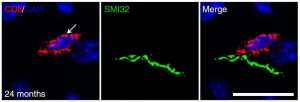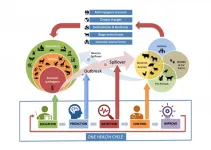(Press-News.org) Almost half of the parents who have children together with a parent with schizophrenia or bipolar disorder, are themselves burdened by psychological issues. This can affect family life and the children. This is shown in the research result from the major Danish psychiatry project iPSYCH.
We typically choose a partner who resembles us in relation to social status, education and, to some extent, also income. Research has previously established this. A new study now shows that almost half of the parents who have children with a partner who suffers from schizophrenia or bipolar disorder themselves meet the criteria for a mental disorder. By comparison, this is 18 percent for parents in the control group.
The results stem from The Danish High-Risk and Resilience Study, which is part of iPSYCH. A total of 872 parents participated in the study. The parental couples were selected such that one of the parents was registered in the National Patient Register with a diagnosis of schizophrenia or bipolar disorder. Their partner and the parents from the control group were not registered with these disorders. At the time of the study, all of the parents had a seven-year-old child.
Met the criteria themselves
"In the Danish registers we used, each child only had one parent registered with a mental disorder, but the diagnostic interview carried out as part of our study showed that almost half of the partners also fulfilled the criteria for such a disorder. In addition, the partners had a lower functional level compared to the control group," says PhD and Psychologist Aja Neergaard Greve, who is behind the study.
"The most frequent diagnosis among the partners was depression. We were surprised that six per cent of the partners to people with schizophrenia also met the diagnostic criteria for schizophrenia themselves. In the control group, it was only one per cent," she says.
Care is often dependent on the other person
According to the researcher, the results - which have been published in the scientific journal Schizophrenia Bulletin - indicate possible risk factors for children who grow up in families with a parent with schizophrenia or bipolar disorder.
"When one of the parents has a severe mental disorder, caring for the child will often be more dependent on the other parent, who perhaps also has much of their attention directed towards the ill parent. If the parent who we thought was healthy and well-functioning also in some cases has a mental disorder, and/or has a lower functional level and is emotionally and practically burdened by the general family situation, then this can have significance for the whole family's well-being," explains Aja Neergaard Greve.
Already at increased risk
Children born to parents with schizophrenia and bipolar disorder have an increased risk of themselves developing mental disorders - in fact, the familial risk is the highest known risk factor for later development of these disorders. If both parents have a mental disorder, the overall risk for the children increases.
"This increased risk is both genetic and environmental. Cognitive functions such as intelligence are e.g. hereditary, but if the parents have cognitive difficulties there will also be an effect on the environment the child grows up in if the parents therefore don't have the opportunity to create good stable routines and predictability or to stimulate the child sufficiently," she says and continues:
"Some of these families are particularly vulnerable and struggle with more than one issue and they therefore need extra help and support. Our study suggests that there is a need for increased attention on some of the families where one or both parents have a mental disorder. There is a need for specialised and targeted efforts for families already early in the child's life," says Aja Neergaard Greve.
The researchers will follow the families from the study up through the child's upbringing and hope to learn more about how the children develop, as well as which factors have greatest importance for the well-being of the families.
Background for the results
The Danish High-Risk and Resilience Study is a nationwide, representative group consisting of 522 children born to parents with schizophrenia, bipolar disorder or parents from the control group. The children and both the child's biological parents have been interviewed and examined. The results of this study stem from data from 872 parents.
INFORMATION:
The study is a collaboration between adult psychiatry in the Central Denmark Region and adult and child and adolescent psychiatry in the Capital Region of Denmark.
The study is financed by the Lundbeck Foundation, Aarhus University, the Central Denmark Region, the Capital Region of Denmark and the Beatrice Surovell Haskell Foundation for Child Mental Health Research of Copenhagen.
The scientific article is published in Schizophrenia Bulletin
Contact
Psychologist & PhD Aja Neergaard Greve
Aarhus University, Department of Clinical Medicine and
Aarhus University Hospital, Psychosis Research Unit
ajagreve@rm.dk
(+45) 6179 7035
Aging is the biggest risk factor for perturbation of the nervous system, even in the absence of distinct disease or trauma. For yet unknown reasons, the impulse conducting, myelinated projections and synaptic connections between nerve cells are especially vulnerable to aging-related degeneration. These pathological alterations often manifest as cognitive, sensory, and motor decline in older adults and represent a serious socio-economic challenge.
Malactivation leads to damage
Scientists have long assumed that inflammation plays an important role in this process. Mal- or overactivation of distinct cells belonging to the innate immune system - the microglia - appears to promote damage of nerve fibers and synapses ...
As the digital revolution has now become mainstream, quantum computing and quantum communication are rising in the consciousness of the field. The enhanced measurement technologies enabled by quantum phenomena, and the possibility of scientific progress using new methods, are of particular interest to researchers around the world.
Recently two researchers at Tampere University, Assistant Professor Robert Fickler and Doctoral Researcher Markus Hiekkamäki, demonstrated that two-photon interference can be controlled in a near-perfect way using ...
For the first time, international experts in psychology have built a framework to diagnose Compulsive Buying-Shopping Disorder - promising help for people struggling to manage their spending behaviour and mental wellbeing.
The new guidelines, published in the Journal of Behavioral Addictions, confirms that excessive buying and shopping can be so serious as to constitute a disorder, giving researchers and clinicians new powers to develop more targeted interventions for this debilitating condition.
The international collaboration, led by Professor Mike Kyrios from Flinders University's Órama Institute for Mental ...
SINGAPORE - A team of researchers from the Agency for Science, Technology and Research's (A*STAR) Genome Institute of Singapore (GIS) and Bioprocessing Technology Institute (BTI), as well as Singapore Eye Research Institute (SERI), have identified a genetic mutation (functionally defective CYP39A1 gene) associated with exfoliation syndrome, the most common cause of glaucoma. The findings could pave the way for future research on the cause of exfoliation syndrome and potential cures. Their research was published in Journal of the American Medical Association (JAMA) on 24 February 2021.
Exfoliation syndrome is a systemic ...
Artificial intelligence that enhances remote monitoring of water bodies - highlighting quality shifts due to climate change or pollution - has been developed by researchers at the University of Stirling.
A new algorithm - known as the 'meta-learning' method - analyses data directly from satellite sensors, making it easier for coastal zone, environmental and industry managers to monitor issues such as harmful algal blooms (HABs) and possible toxicity in shellfish and finfish.
Environmental protection agencies and industry bodies currently monitor the 'trophic state' of water - its biological productivity - as an indicator of ecosystem health. Large clusters of microscopic algae, or phytoplankton, is called eutrophication and can ...
Mangroves and seagrasses grow in many places along the coasts of the world, and these 'blue forests' constitute an important environment for a large number of animals. Here, juvenile fish can hide until they are big enough to take care of themselves; crabs and mussels live on the bottom; and birds come to feed on the plants.
However, the plant-covered coastal zones do not only attract animals but also microplastics, a new study shows.
- The denser the vegetation, the more plastic is captured, says Professor and expert in coastal ecology, Marianne Holmer, from the University of Southern Denmark.
She is concerned about how the accumulated microplastics affect animal and plant life.
- We know from other ...
The EU-funded BIO-CRIME project - with support from the Leibniz Institute for Zoo and Wildlife Research (Leibniz-IZW) - conducted a scientific investigation on the topic of illegal small animal trade and the associated risk of pathogen transmission.
The study focused on the key areas of "illegal small animal trade" and the level of knowledge and proper behaviours of young people and adolescents with "zoonotic diseases" and the "One Health concept". One Health is an approach that recognises that human health is closely linked to the health of animals and our shared ...
In 2019 the climate movement experienced an unprecedented growth in its mobilization capacity and its political and media impact. The success of the movement is closely linked to the figure of Greta Thunberg and the global impact of her discourse and the "Fridays for Future" movement in hundreds of cities around the world.
A study by Silvia Díaz-Pérez, Roger Soler-i-Martí and Mariona Ferrer-Fons, members of the UPF JOVIS research group of the Department of Communication, analyses the activist's speeches and messages on social networks and their legitimization through her personal story, and it also looks into the "Fridays for Future" movement in Barcelona, based on Twitter and Instagram posts. The research was based on a project that has received funding from ...
Cryptocurrencies like Bitcoin are becoming increasingly popular. At first glance, they have many advantages: Transactions are usually anonymous, fast and inexpensive. But sometimes there are problems with them. In certain situations, fraud is possible, users can discover information about other users that should be kept secret, and sometimes delays occur.
The research unit "Security and Privacy" at TU Wien (Lukas Aumayr and his supervisor Prof. Matteo Maffei) in collaboration with the IMDEA Software Institute (Prof. Pedro Moreno-Sanchez, previously postdoc at TU Wien) and the Purdue University (Prof. Aniket Kate) analyzed these problems and developed an improved protocol. It has now been published and will be presented this year at ...
Sea turtles in the Cayman Islands are recovering from the brink of local extinction, new research shows.
Monitoring from 1998-2019 shows loggerhead and green turtle nest numbers increased dramatically, though hawksbill turtle nest numbers remain low.
In the first counts in 1998-99, just 39 sea turtle nests were found in total on the three islands. By 2019, the figure was 675.
Captive breeding of green turtles and inactivity of a traditional turtle fishery due to tightening of restrictions in 2008 contributed to this - but populations remain far below historical levels and still face threats including ...








